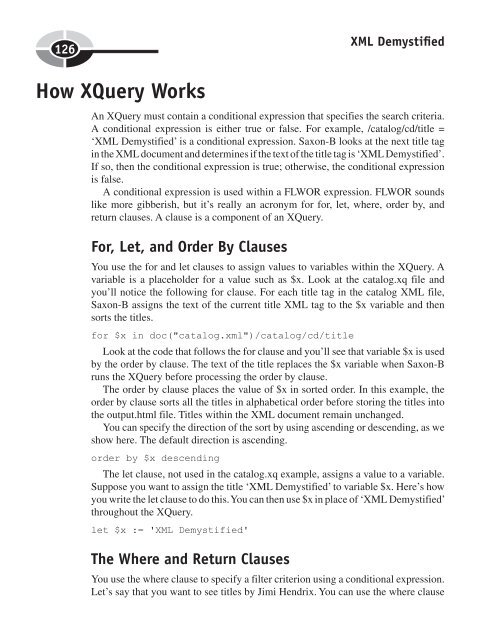You also want an ePaper? Increase the reach of your titles
YUMPU automatically turns print PDFs into web optimized ePapers that Google loves.
126<br />
How XQuery Works<br />
<strong>XML</strong> Demystifi ed<br />
An XQuery must contain a conditional expression that specifies the search criteria.<br />
A conditional expression is either true or false. For example, /catalog/cd/title =<br />
‘<strong>XML</strong> <strong>Demystified</strong>’ is a conditional expression. Saxon-B looks at the next title tag<br />
in the <strong>XML</strong> document and determines if the text of the title tag is ‘<strong>XML</strong> <strong>Demystified</strong>’.<br />
If so, then the conditional expression is true; otherwise, the conditional expression<br />
is false.<br />
A conditional expression is used within a FLWOR expression. FLWOR sounds<br />
like more gibberish, but it’s really an acronym for for, let, where, order by, and<br />
return clauses. A clause is a component of an XQuery.<br />
For, Let, and Order By Clauses<br />
You use the for and let clauses to assign values to variables within the XQuery. A<br />
variable is a placeholder for a value such as $x. Look at the catalog.xq file and<br />
you’ll notice the following for clause. For each title tag in the catalog <strong>XML</strong> file,<br />
Saxon-B assigns the text of the current title <strong>XML</strong> tag to the $x variable and then<br />
sorts the titles.<br />
for $x in doc("catalog.xml")/catalog/cd/title<br />
Look at the code that follows the for clause and you’ll see that variable $x is used<br />
by the order by clause. The text of the title replaces the $x variable when Saxon-B<br />
runs the XQuery before processing the order by clause.<br />
The order by clause places the value of $x in sorted order. In this example, the<br />
order by clause sorts all the titles in alphabetical order before storing the titles into<br />
the output.html file. Titles within the <strong>XML</strong> document remain unchanged.<br />
You can specify the direction of the sort by using ascending or descending, as we<br />
show here. The default direction is ascending.<br />
order by $x descending<br />
The let clause, not used in the catalog.xq example, assigns a value to a variable.<br />
Suppose you want to assign the title ‘<strong>XML</strong> <strong>Demystified</strong>’ to variable $x. Here’s how<br />
you write the let clause to do this. You can then use $x in place of ‘<strong>XML</strong> <strong>Demystified</strong>’<br />
throughout the XQuery.<br />
let $x := '<strong>XML</strong> <strong>Demystified</strong>'<br />
The Where and Return Clauses<br />
You use the where clause to specify a filter criterion using a conditional expression.<br />
Let’s say that you want to see titles by Jimi Hendrix. You can use the where clause


